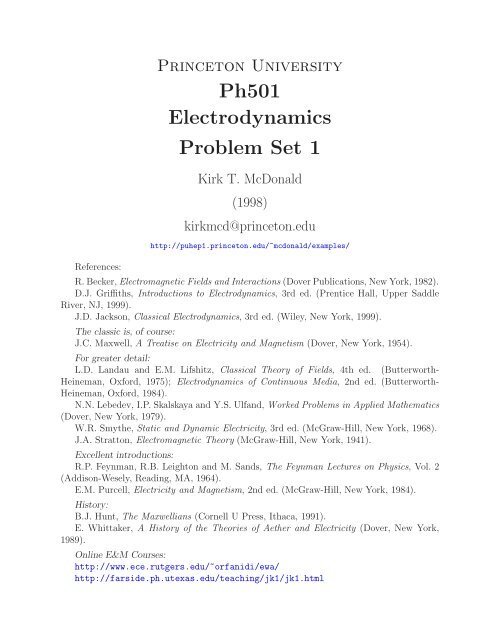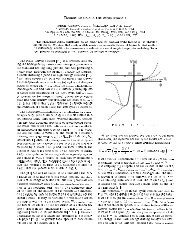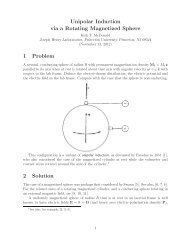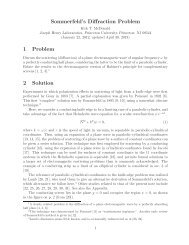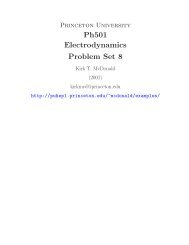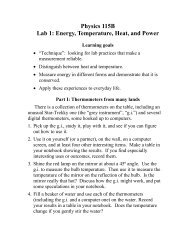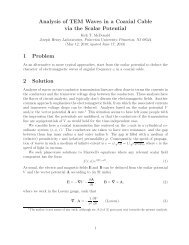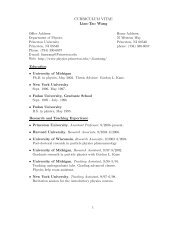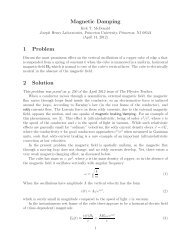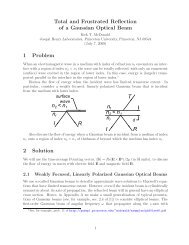Ph501 Electrodynamics Problem Set 1 - Princeton University
Ph501 Electrodynamics Problem Set 1 - Princeton University
Ph501 Electrodynamics Problem Set 1 - Princeton University
Create successful ePaper yourself
Turn your PDF publications into a flip-book with our unique Google optimized e-Paper software.
<strong>Princeton</strong> <strong>University</strong><br />
<strong>Ph501</strong><br />
<strong>Electrodynamics</strong><br />
<strong>Problem</strong> <strong>Set</strong> 1<br />
Kirk T. McDonald<br />
(1998)<br />
kirkmcd@princeton.edu<br />
http://puhep1.princeton.edu/~mcdonald/examples/<br />
References:<br />
R. Becker, Electromagnetic Fields and Interactions (Dover Publications, New York, 1982).<br />
D.J. Griffiths, Introductions to <strong>Electrodynamics</strong>, 3rd ed. (Prentice Hall, Upper Saddle<br />
River, NJ, 1999).<br />
J.D. Jackson, Classical <strong>Electrodynamics</strong>, 3rd ed. (Wiley, New York, 1999).<br />
The classic is, of course:<br />
J.C. Maxwell, A Treatise on Electricity and Magnetism (Dover, New York, 1954).<br />
For greater detail:<br />
L.D. Landau and E.M. Lifshitz, Classical Theory of Fields, 4th ed. (Butterworth-<br />
Heineman, Oxford, 1975); <strong>Electrodynamics</strong> of Continuous Media, 2nd ed. (Butterworth-<br />
Heineman, Oxford, 1984).<br />
N.N. Lebedev, I.P. Skalskaya and Y.S. Ulfand, Worked <strong>Problem</strong>s in Applied Mathematics<br />
(Dover, New York, 1979).<br />
W.R. Smythe, Static and Dynamic Electricity, 3rd ed. (McGraw-Hill, New York, 1968).<br />
J.A. Stratton, Electromagnetic Theory (McGraw-Hill, New York, 1941).<br />
Excellent introductions:<br />
R.P. Feynman, R.B. Leighton and M. Sands, The Feynman Lectures on Physics, Vol.2<br />
(Addison-Wesely, Reading, MA, 1964).<br />
E.M. Purcell, Electricity and Magnetism, 2nd ed. (McGraw-Hill, New York, 1984).<br />
History:<br />
B.J. Hunt, The Maxwellians (Cornell U Press, Ithaca, 1991).<br />
E. Whittaker, A History of the Theories of Aether and Electricity (Dover, New York,<br />
1989).<br />
Online E&M Courses:<br />
http://www.ece.rutgers.edu/~orfanidi/ewa/<br />
http://farside.ph.utexas.edu/teaching/jk1/jk1.html
<strong>Princeton</strong> <strong>University</strong> 1998 <strong>Ph501</strong> <strong>Set</strong> 1, <strong>Problem</strong> 1 1<br />
1. (a) Show that the mean value of the potential over a spherical surface is equal to the<br />
potential at the center, provided that no charge is contained within the sphere.<br />
(A related result is that the mean value of the electric field over the volume of a<br />
charge-free sphere is equal to the value of the field at its center.)<br />
(b) Demonstrate Earnshaw’s theorem: A charge cannot be held at equilibrium solely<br />
by an electrostatic field. 1<br />
(c) Demonstrate that an electrostatic field E cannot have a local maximum of E 2 ,<br />
using the mean value theorem mentioned in part (a) – or any other technique.<br />
Remark: An interesting example of nonelectrostatic equilibrium is laser trapping<br />
of atoms. Briefly, an atom of polarizability α takes on an induced dipole moment<br />
p = αE in an electric field. The force on this dipole is then (Notes, p. 26),<br />
F = ∇(p · E) =α∇E 2 . Since an electrostatic field cannot have a local maximum<br />
of E 2 , it cannot trap a polarizable atom. But consider an oscillatory field, in<br />
particular a focused light wave. The time-average force, 〈F〉 = α∇ 〈E 2 〉 draws<br />
the atom into the laser focus where the electric field is a maximum. See,<br />
http://puhep1.princeton.edu/~mcdonald/examples/tweezers.pdf<br />
1 http://puhep1.princeton.edu/~mcdonald/examples/EM/earnshaw_tcps_7_97_39.pdf
<strong>Princeton</strong> <strong>University</strong> 1998 <strong>Ph501</strong> <strong>Set</strong> 1, <strong>Problem</strong> 2 2<br />
2. Calculate the potential φ(z) along the axis of a disk of radius R in two cases:<br />
(a) The disk is a uniform layer of charge density σ, and<br />
(b) The disk is a uniform dipole layer of dipole moment density p = pẑ per unit area.
<strong>Princeton</strong> <strong>University</strong> 1998 <strong>Ph501</strong> <strong>Set</strong> 1, <strong>Problem</strong> 3 3<br />
3. Suppose the electric field of point charge q were E = qˆr/r 2+δ where δ ≪ 1, rather then<br />
E = qˆr/r 2 .<br />
(a) Calculate ∇ · E and ∇ × E for r ≠ 0. Find the electric potential for such a point<br />
charge.<br />
(b) Two concentric spherical conducting shells of radii a and b are joined by a thin<br />
conducting wire. Show that if charge Q a resides on the outer shell, then the charge<br />
on the inner shell is<br />
Q b ≃−<br />
Q aδ<br />
[2b ln 2a − (a + b)ln(a + b)+(a − b)ln(a − b)] (1)<br />
2(a − b)
<strong>Princeton</strong> <strong>University</strong> 1998 <strong>Ph501</strong> <strong>Set</strong> 1, <strong>Problem</strong> 4 4<br />
4. (a) Starting from the dipole potential φ = p · r/r 3 explicitly show that<br />
E =<br />
3(p · ˆr)ˆr − p<br />
r 3<br />
− 4πp<br />
3 δ3 (r). (2)<br />
Hint: to show the need for the δ 3 (r) term, consider the volume integral of E over<br />
a small sphere about the dipole. You may need a variation of Gauss’ theorem:<br />
∫<br />
∮<br />
∇φ dVol = φˆn dS, (3)<br />
V<br />
where ˆn is the outward normal to the surface.<br />
(b) The geometric definition of the “lines of force” is that this family of curves obeys<br />
the differential equation:<br />
dx<br />
= dy = dz . (4)<br />
E x E y E z<br />
For a dipole p = pẑ, find the equation of the lines of force in the x-z plane. It is<br />
easiest to work in spherical coordinates. Compare with the figure on the cover of<br />
the book by Becker.<br />
S
<strong>Princeton</strong> <strong>University</strong> 1998 <strong>Ph501</strong> <strong>Set</strong> 1, <strong>Problem</strong> 5 5<br />
5. Find the two lowest-order nonvanishing terms in the multipole expansion of the potential<br />
due to a uniformly charged ring of radius a carrying total charge Q. Takethe<br />
origin at the center of the ring, and neglect the thickness of the ring.
<strong>Princeton</strong> <strong>University</strong> 1998 <strong>Ph501</strong> <strong>Set</strong> 1, <strong>Problem</strong> 6 6<br />
6. (a) A long, very thin rod of dielectric constant ɛ is oriented parallel to a uniform<br />
electric field E ext .WhatareE and D inside the rod?<br />
(b) What are E and D inside a very thin disc of dielectric constant ɛ if the disc is<br />
perpendicular to E ext ?<br />
(c) Find E and D everywhere due to a sphere of fixed uniform polarization density<br />
P. Thencalculate ∫ E·D dVol for the two volumes inside and outside the sphere’s<br />
surface.<br />
Hint: this problem is equivalent to two oppositely charged spheres slightly displaced.<br />
(d) Show that for any finite electret, a material with fixed polarization P,<br />
∫<br />
all space<br />
E · D dVol = 0. (5)
<strong>Princeton</strong> <strong>University</strong> 1998 <strong>Ph501</strong> <strong>Set</strong> 1, <strong>Problem</strong> 7 7<br />
7. A spherical capacitor consists of two concentric conducting shells of radii a and b.<br />
The gap is half filled with a (non-conducting) dielectric liquid of constant ɛ. Youmay<br />
assume the fields are radial. The inner shell carries charge +Q, the outer shell −Q.<br />
Calculate E and D in the gap, and the charge distribution in the inner shell. Also<br />
calculate the capacitance, defined as C = Q/V ,whereV is the potential difference<br />
between the inner and outer shells.
<strong>Princeton</strong> <strong>University</strong> 1998 <strong>Ph501</strong> <strong>Set</strong> 1, <strong>Problem</strong> 8 8<br />
8. (a) As a classical model for atomic polarization, consider an atom consisting of a fixed<br />
nucleus of charge +e with an electron of charge −e in a circular orbit of radius a<br />
about the nucleus. An electric field is applied at right angles to the plane of the<br />
orbit. Show that the polarizability α is approximately a 3 . (This happens to be<br />
the result of Becker’s (26-6), but the model is quite different!)<br />
Assuming that radius a is the Bohr radius, ∼ 5.3 × 10 −9 cm, use the model<br />
to estimate the dielectric constant ɛ of hydrogen gas at S.T.P. Empirically, ɛ ∼<br />
1+2.5 × 10 −4 .<br />
(b) Another popular classical model of an atom is that the electron is bound to a<br />
neutral nucleus by a spring whose natural frequency of vibration is that of some<br />
characteristic spectral line. For hydrogen, a plausible choice is the Lyman line at<br />
1225 Angstroms. In this model, show that α = e 2 /mω 2 , and estimate ɛ. Recall<br />
that e =4.8 × 10 −10 esu, and m =9.1 × 10 −28 g.
<strong>Princeton</strong> <strong>University</strong> 1998 <strong>Ph501</strong> <strong>Set</strong> 1, Solution 1 9<br />
Solutions<br />
1. a) We offer two solutions: the first begins by showing the result holds for small spheres,<br />
and then shows the result is independent of the size of the (charge-free) sphere; the<br />
second applies immediately for spheres of any size, but is more abstract.<br />
We consider a charge-free sphere of radius R centered on the origin.<br />
In a charge-free region, the potential φ(r) satisfies Laplace’s equation:<br />
∇ 2 φ =0. (6)<br />
First, we simply expand the potential in a Taylor series about the origin:<br />
φ(r) =φ(0) + ∑ i<br />
∂φ(0)<br />
x i + 1 ∑ ∂ 2 φ(0)<br />
x i x j + ... (7)<br />
∂x i 2<br />
i,j<br />
∂x i ∂x j<br />
We integrate (7) over the surface of the sphere:<br />
∮<br />
φ(r)dS =4πR 2 φ(0) + ∑ ∂φ(0)<br />
x i dS +<br />
S<br />
i<br />
∂x i<br />
∮S 1 ∑ ∂ 2 φ(0)<br />
x i x j dS + ... (8)<br />
2<br />
i,j<br />
∂x i ∂x j<br />
∮S<br />
For a very small sphere, we can ignore all terms except the first, In this case, eq. (8)<br />
becomes<br />
1<br />
φ(r)dS = φ(0), [R “small”], (9)<br />
4πR 2 ∮S<br />
which was to be shown.<br />
Does the result still hold at larger radii? One might expect that since “small” is not<br />
well defined, (9) holds for arbitrary R, so long as the sphere is charge free.<br />
Progress can be made staying with the Taylor expansion. By spherical symmetry, the<br />
integral of the product of an odd number of x i vanishes. Hence, only the terms with<br />
even derivatives of the potential survive. And of these, only some terms survive. In<br />
particular, for the 2nd derivative, only the integrals of x 2 1, x 2 2,andx 2 3 survive, and these<br />
3 are all equal. Thus, the 2nd derivative term consists of<br />
(<br />
1 ∂ 2 ) ∮<br />
φ(0)<br />
+ ∂2 φ(0)<br />
+ ∂2 φ(0)<br />
x 2<br />
2 ∂x 2 1 ∂x 2 2 ∂x<br />
1dS, (10)<br />
2<br />
3 S<br />
which vanishes, since ∇ 2 φ(0) = 0.<br />
It is less evident that the terms with 4rth and higher even derivatives vanish, although<br />
this can be shown via a systematic multipole expansion in spherical coordinates, which<br />
emphasizes the spherical harmonics Yl m .<br />
But by a different approach, we can show that the mean value of the potential over a<br />
charge-free sphere is independent of the radius of the sphere. That is, consider<br />
M(r) = 1 φdS =<br />
4πr<br />
∮S<br />
1 ∫<br />
2 4π<br />
∫<br />
d cos θ<br />
dϕφ(r, θ, ϕ), (11)
<strong>Princeton</strong> <strong>University</strong> 1998 <strong>Ph501</strong> <strong>Set</strong> 1, Solution 1 10<br />
in spherical coordinates (r, θ, ϕ). Then<br />
dM(r)<br />
dr<br />
= 1 ∫<br />
4π<br />
1<br />
=<br />
4πr 2 ∮S<br />
∫<br />
d cos θ<br />
dϕ ∂φ<br />
∂r = 1 ∫<br />
4π<br />
∫<br />
d cos θ<br />
dϕ∇φ · ˆr<br />
∇φ · dS = 1 ∇<br />
4πr<br />
∫V<br />
2 φdVol = 0, (12)<br />
2<br />
for a charge-free volume. Hence, the mean value of the potential over a charge-free<br />
sphere of finite radius is the same as that over a tiny sphere about the center of the<br />
larger sphere. But, as shown in the argument leading up to (9), this is just the value<br />
of the potential at the center of the sphere.<br />
A second solution is based on one of Green’s theorems (sec. 1.8 Of Jackson). Namely,<br />
for two reasonable functions φ(r) andψ(r),<br />
∫<br />
V<br />
(<br />
φ∇ 2 ψ − ψ∇ 2 φ ) ∮<br />
dVol =<br />
S<br />
(<br />
φ ∂ψ<br />
∂n − ψ ∂φ )<br />
dS, (13)<br />
∂n<br />
where n is coordinate normally outward from the closed surface S surrounding a volume<br />
V .<br />
With φ as the potential satisfying Laplace’s equation (6), the second term on the l.h.s.<br />
of (13) vanishes. We seek an auxiliary function ψ such that ∇ 2 ψ = δ 3 (0), so the l.h.s.<br />
is just φ(0). Further, it will be helpful if ψ vanishes on the surface of the sphere of<br />
radius R, so the second term on the r.h.s. vanishes also.<br />
These conditions are arranged with the choice<br />
ψ = 1 ( 1<br />
4π R − 1 )<br />
, (14)<br />
r<br />
recalling pp. 8-9 of the Notes. On the surface of the sphere, coordinate n is just the<br />
radial coordinate r, so<br />
∂ψ<br />
∂n = 1<br />
4πr . (15)<br />
2<br />
Thus, we can evaluate the expression (13), and get:<br />
ψ(0) = 1 φdS, (16)<br />
4πR<br />
∮S<br />
2<br />
which means that the value of the potential φ at the center of a charge-free sphere of<br />
any size is the average of the potential on the surface of the sphere.<br />
b) The potential energy of a charge q at point r, due to interaction with an electrostatic<br />
field derivable from a potential φ(r), is:<br />
U = qφ(r). (17)<br />
For the point r 0 to be the equilibrium point for a particle, the potential φ should have<br />
a minimum there. But we can infer from part (a) that:
<strong>Princeton</strong> <strong>University</strong> 1998 <strong>Ph501</strong> <strong>Set</strong> 1, Solution 1 11<br />
Harmonic functions do not have minima,<br />
harmonic functions being a name for solutions of Laplace’s equation (6).<br />
Indeed, a minimum of U at point r 0 would imply that there is a small sphere centered<br />
on r 0 such that φ(r 0 )islessthanφ at any point on that sphere. This would contradict<br />
what we have shown in part (a): φ(r 0 ) is the average of φ over the sphere.<br />
We continue with an example of Earnshaw’s theorem. Consider 8 unit charges located<br />
at the corners of a cube of edge length 2, i.e., the charges are at the locations (x i ,y i ,z i )<br />
= (1,1,1), (1,1,-1), (1,-1,1), (1,-1, -1), (-1,1,1), (-1,1,-1), (-1,-1,1), (-1,-1,1). It is suggestive,<br />
but not true, that the electric field near the origin points inwards and could<br />
trap a positive charge.<br />
The symmetry of the problem is such that a series expansion of the electric potential<br />
near the origin will have terms with only even powers, and we must go to 4rth order to<br />
see that the potential does not have a maximum at the origin. To simplify the series<br />
expansion, we consider the electric field, for which we need expand only to third order.<br />
The electric potential is given by<br />
φ =<br />
8∑<br />
i=1<br />
The x component of the electric field is<br />
1<br />
√(x i − x) 2 +(y i − y) 2 +(z i − z) 2 . (18)<br />
E x = − ∂φ 8∑<br />
∂x = − x i − x<br />
[(x i − x) 2 +(y i − y) 2 +(z i − z) 2 ] 3/2<br />
i=1<br />
= − 1 8∑<br />
x i − x<br />
3 3/2 i=1<br />
[1 + (−2x i x − 2y i y − 2z i z + x 2 + y 2 + z 2 )/3] 3/2<br />
≈ − 1 [<br />
8∑<br />
x<br />
3 3/2 i 1+y i y + z i z + −2x2 + y 2 + z 2 ]<br />
+5y i yz i z<br />
i=1<br />
3<br />
− 1 [<br />
8∑ 11yi y 3 +11z i z 3<br />
x<br />
3 3/2 i − x2 y i y + x 2 z i z<br />
+ 3y2 z i z +3z 2 ]<br />
y i y<br />
i=1<br />
54<br />
6<br />
2<br />
− 1<br />
[<br />
8∑ 2xyi y +2xz i z<br />
− 7x3<br />
3 3/2 i=1<br />
3 54 + 7xy2 +7xz 2<br />
+ 20xy ]<br />
iyz i z<br />
6<br />
9<br />
28<br />
=<br />
81 √ 3 (x3 − 9xy 2 − 9xz 2 ), (19)<br />
noting that x 2 i = yi 2 = zi 2 =1andthat ∑ x i =0= ∑ x i y i , etc. Similarly,<br />
E y ≈ 28<br />
81 √ 3 (y3 − 9yx 2 − 9yz 2 ) and E z ≈ 28<br />
81 √ 3 (z3 − 9zx 2 − 9zy 2 ). (20)<br />
The radial component of the electric field is therefore<br />
E r = E · r<br />
r<br />
= xE x + yE y + zE z<br />
r<br />
≈ 28<br />
81 √ 3r [x4 + y 4 + z 4 − 18(x 2 y 2 + y 2 z 2 + z 2 x 2 )]. (21)
<strong>Princeton</strong> <strong>University</strong> 1998 <strong>Ph501</strong> <strong>Set</strong> 1, Solution 1 12<br />
Along the x axis, r = x and the radial field varies like<br />
but along the diagonal x = y = z = r/ √ 3 it varies like<br />
E r ≈ 28<br />
81 √ 3 r3 > 0, (22)<br />
E r ≈− 476<br />
243 √ 3 r3 < 0. (23)<br />
It is perhaps not intuitive that the electric field is positive along the positive x axis,<br />
although Earnshaw assures us that the radial electric field must be positive in some<br />
direction. A clue is to consider the point (1,0,0) on the face of the cube whose corners<br />
hold the charges. At this point the electric fields due to the 4 charges with x =1sum<br />
to zero, so the field here is due only to the 4 charges with x = −1, and now “obviously”<br />
the x component of the electric field is positive. The charges at the corners of the cube<br />
force a positive charge toward the origin along the diagonals, but cannot prevent that<br />
charge from escaping near the centers of the faces of the cube.<br />
c) If E 2 has a local maximum at some point P in a charge-free region, then there is a<br />
nonzero r such that E 2
<strong>Princeton</strong> <strong>University</strong> 1998 <strong>Ph501</strong> <strong>Set</strong> 1, Solution 2 13<br />
2. a) The potential φ(z) along the axis of a disk of radius R of charge density σ (per unit<br />
area) is given by the integral:<br />
φ(z) =<br />
∫ R<br />
r=0<br />
σ<br />
2πrdr√ r2 + z =2πσ ( √<br />
R2 + z 2 −|z| ) . (26)<br />
2<br />
Notice that φ(z) behaves as πσR 2 /|z| for |z| ≫R, which is consistent with the observation<br />
that in this limit the disk may be considered as a point charge q = πσR 2 .<br />
Notice also, that at z = 0 the potential is continuous, but it’s first derivative (−E)<br />
jumps from −2πσ at z =0 + to 2πσ at z =0 − . This reflects the fact that at small |z|<br />
(|z| ≪R) the potential may be calculated, in first approximation, as the potential for<br />
the infinite plane with charge density σ.<br />
b) A disk of dipole-moment density p = pẑ can be thought of as composed of a layer<br />
of charge density +σ separated in z from a layer of charge density −σ by a distance<br />
d = p/σ. Say, the + layer is at z = d/2, and the − layer is as z = −d/2. Then, the<br />
potential φ b at distance z along the axis could be written in terms of φ a (z) found in<br />
(26) as<br />
φ b (z) =φ a (z − d/2) − φ a (z + d/2) →−d ∂φ a(z)<br />
∂z<br />
=2πp<br />
(<br />
sign(z) −<br />
)<br />
z<br />
√ . (27)<br />
R2 + z 2<br />
In this, we have taken the limit as d → 0 while σ →∞, but p = σd is held constant.<br />
At large z we get the potential of a dipole P = πpR 2 on its axis. But near the plate<br />
(|z| ≪R), the potential has a discontinuity:<br />
φ b (0 + ) − φ b (0 − )=4πp. (28)<br />
We may explain this in our model of the dipole layer as a system of two close plates<br />
with charge density σ and distance d between them, where p = σd. The field between<br />
the plates is E z = −4πσ, and the potential difference potential between two plates is<br />
as found in (28).<br />
Δφ = −E z d =4πp, (29)
<strong>Princeton</strong> <strong>University</strong> 1998 <strong>Ph501</strong> <strong>Set</strong> 1, Solution 3 14<br />
3. a) For a charge q at the origin, the proposed electric field is<br />
E = q ˆr<br />
r = q r . (30)<br />
2+δ r3+δ This still has spherical symmetry, so we can easily evaluate the divergence and curl in<br />
spherical coordinates:<br />
∇ · E = q ∇ · r 1<br />
+ qr · ∇<br />
r3+δ r = 3q 3+δ<br />
− q = − qδ ; (31)<br />
3+δ r3+δ r 3+δ r3+δ ∇ × E = q ∇ × r + ∇ 1<br />
r<br />
× qr =0− (3 + δ) × qr =0. (32)<br />
r 3+δ r3+δ r5+δ Since ∇ × E = 0, the field can be derived from a potential. Indeed,<br />
∫ r<br />
E = −∇φ, where φ = −<br />
∞<br />
∫ r<br />
E r dr = −q<br />
∞<br />
dr<br />
r 2+δ = 1<br />
q<br />
. (33)<br />
δ +1rδ+1 b) Let us first compute the potential due to a the spherical shell of radius a that carries<br />
charge Q, as observed at a distance r from the center of the sphere. We use (33) and<br />
integrate in spherical coordinates (r, θ, φ) to find<br />
φ(r) =<br />
Q<br />
4πa 2 1<br />
1+δ<br />
∫ 1<br />
−1<br />
2πar 2 d cos θ<br />
(a 2 + r 2 − 2ar cos θ) 1+δ<br />
2<br />
= Q (a + r) 1−δ −|a − r| 1−δ<br />
2ar 1 − δ 2 . (34)<br />
Now consider the addition of a sphere of radius b
<strong>Princeton</strong> <strong>University</strong> 1998 <strong>Ph501</strong> <strong>Set</strong> 1, Solution 4 15<br />
4. a) The first terms in E can be obtained by explicit differentiation, perhaps best done<br />
using vector components. For r>0,<br />
E i = − ∂ p j x j<br />
∂x i r 3<br />
= 3(p jx j )x i<br />
r 5<br />
− p i<br />
r 3 . (40)<br />
To justify the δ-term, consider the integral over a small sphere surrounding the (point)<br />
dipole:<br />
∫<br />
∫<br />
∮<br />
∮<br />
p · r<br />
EdVol = − ∇φdVol = φˆndS = ˆrdS, (41)<br />
V<br />
V<br />
S<br />
S r3 according to the form of Gauss’ law (3) given in the hint. Evaluating the last integral in<br />
a spherical coordinate system with z axis along p, we find that only the ˆp component<br />
is nonzero:<br />
∫<br />
∫ 1<br />
EdVol = p<br />
−1<br />
2πdcos θ cos 2 θ = 4πp<br />
3 . (42)<br />
No matter how small the sphere, the integral (42) remains the same.<br />
On the other hand, if we insert the field E from (40) in the volume integral, only the<br />
z component (along p) does not immediately vanish, but then<br />
∫<br />
V<br />
E z dVol =<br />
∫ r<br />
0<br />
2πrdr<br />
∫ 1<br />
−1<br />
d cos θ p(3 cos2 θ − 1)<br />
r 3 =0, (43)<br />
if we adopt the convention that the angular integral is performed first.<br />
To reconcile the results (42) and (43), we write that the dipole field has a spike near<br />
the origin symbolized by −(4πp/3)δ 3 (r).<br />
Another qualitative reason for the δ-term is as follows. Notice, that without this term<br />
we would conclude that the electric field on the axis of the dipole (z-axis) would always<br />
along +z. This would imply that if we moved some distribution of charge from large<br />
negative z to large positive z, then that charge would gain energy from the dipole<br />
field. But this cannot be true: after all, the dipole may be thought as a system of two<br />
charges, separated by a small distance, and for such a configuration the potential at<br />
large distances is certainly extremely small.<br />
We can also say that the δ-term, which points in the −p direction, represents the large<br />
field in the small region between two charges that make up the dipole.<br />
b) In spherical coordinates with ẑ along p, the dipole potential in the x-z plane is<br />
Then,<br />
E r = − ∂φ<br />
∂r<br />
φ(r, θ) = p cos θ<br />
r 2 (44)<br />
=<br />
2p cos θ<br />
r 3 , and E θ = − ∂φ<br />
r∂θ = p sin θ<br />
r 3 . (45)
<strong>Princeton</strong> <strong>University</strong> 1998 <strong>Ph501</strong> <strong>Set</strong> 1, Solution 4 16<br />
Thus, the differential equation of the field lines<br />
dr<br />
E r<br />
= rdθ<br />
E θ<br />
,<br />
implies<br />
dr<br />
r<br />
=2d<br />
sin θ<br />
sin θ , (46)<br />
which integrates to<br />
etc.<br />
r = C sin 2 θ = C x2<br />
r 2 , (47)
<strong>Princeton</strong> <strong>University</strong> 1998 <strong>Ph501</strong> <strong>Set</strong> 1, Solution 5 17<br />
5. The multipole expansion of the potential φ about the origin due to a localized charge<br />
distribution ρ(r) is<br />
φ(r) = Q r + P · ˆr + 1 Q ijˆr iˆr j<br />
+ ... (48)<br />
r 2 2 r 3<br />
where<br />
∫<br />
∫<br />
∫<br />
Q = ρ(r)dVol, P i = ρr i dVol, Q ij = ρ(3r i r j − δ ij r 2 )dVol, ... (49)<br />
For the ring, Q is just the total charge, while the dipole moment P is zero because of<br />
the symmetry.<br />
Let us find the quadrupole moment, Q ij .Takethez axis to be along that of the ring.<br />
Then, the quadrupole tensor is diagonal, and due to the rotational invariance,<br />
We compute Q xx in spherical coordinates (r, θ, ϕ):<br />
Q xx = Q yy = − 1 2 Q zz. (50)<br />
∫<br />
Q xx =<br />
ρ(3x 2 − r 2 )dVol =<br />
∫ 2π<br />
0<br />
Q<br />
2πa a2 (3 cos 2 ϕ − 1)adϕ = Qa2<br />
2 . (51)<br />
Thus, the third term in the expansion (48) is:<br />
1<br />
2r 3 (<br />
Qxx sin 2 θ cos 2 ϕ + Q yy sin 2 θ sin 2 ϕ + Q zz cos 2 θ ) = − Qa2<br />
4r 3 (3 cos2 θ − 1). (52)
<strong>Princeton</strong> <strong>University</strong> 1998 <strong>Ph501</strong> <strong>Set</strong> 1, Solution 6 18<br />
6. a) Remember that E is defined as a mean electric field, due to both the external field<br />
and the microscopic charges.<br />
In the presence of external field E ext , polarization P is induced in the rod. Since<br />
∇ × E = 0, the tangential electric field is continuous across the surface of the rod.<br />
This suggests that inside the rod, which is parallel to E ext ,wehaveE = E ext .<br />
To check for consistency, note that in this case, P is constant apart from the ends.<br />
There is no net polarization charge in the bulk of the rod, and no change in the electric<br />
field from E ext . But at the ends there are charges ±Q, whereQ = PA,andA is<br />
the cross-sectional area of the rod. Since A is very small for the thin rod, and the<br />
ends of a long rod are far away from most of the rod, these charges do not contribute<br />
significantly to the electric field. Hence our hypothesis is satisfactory.<br />
The electric displacement can then be deduced as D = ɛE = ɛE ext inside the rod.<br />
b) For a dielectric disk perpendicular to E ext , the normal component of the fields is<br />
naturally emphasized. Recall that ∇ · D implies that the normal component of the<br />
displacement D is continuous across the dielectric boundary.<br />
Outside the disk, where ɛ =1,D = E = E ext is normal to the surface. (That E = E ext<br />
may be justified by noting that the induced charges on two surfaces of the thin disk<br />
have opposite signs and do not contribute to the field outside of the disk.) Thus, inside<br />
the disk, D = E ext . Lastly, inside the disk E = D/ɛ = E ext /ɛ.<br />
c) The problem of a dielectric sphere of uniform polarization density P is equivalent<br />
to two homogeneous spheres with charge densities ρ and −ρ, displaced by distance d,<br />
such that in the limit d → 0, ρ →∞but ρd = P.<br />
Recall that for a sphere of uniform charge density ρ, the interior electric field is<br />
E = 4π 3<br />
ρr. (53)<br />
Thus, inside the polarized sphere we have<br />
{ 4π<br />
E = lim<br />
3 ρ(r − d) − 4π }<br />
3 ρr = − 4π 3<br />
The displacement is<br />
Then,<br />
∫<br />
inside<br />
lim ρd = −4πP<br />
3 . (54)<br />
D = E +4πP = 8πP<br />
3 . (55)<br />
E · DdVol = − 4πP<br />
3<br />
8πP<br />
3<br />
4πr 3<br />
3<br />
= − 128π2 r 3 P 2<br />
. (56)<br />
27<br />
Outside the sphere, the electric field is effectively due to two point charges q =4πρr 3 /3<br />
separated by small distance d, whereρd = P. The external field is simply that of a<br />
point dipole at the origin of strength<br />
p = 4πr3 P<br />
. (57)<br />
3
<strong>Princeton</strong> <strong>University</strong> 1998 <strong>Ph501</strong> <strong>Set</strong> 1, Solution 6 19<br />
Then,<br />
and D = E. Thus,<br />
∫<br />
outside<br />
∫<br />
= p 2 ∞<br />
r<br />
E · DdVol =<br />
4πr 2 dr<br />
r 6<br />
∫∞<br />
+3p 2<br />
E =<br />
3ˆr(p · ˆr) − p<br />
r 3 , (58)<br />
∫ p 2 +3(p · ˆr) 2 )<br />
r 6 dVol (59)<br />
r<br />
2πr 2 ∫1<br />
dr<br />
r 6<br />
−1<br />
cos 2 θdcos θ = 8πp2 = 128π3 r 3 P 2<br />
,<br />
3r 3 27<br />
and the sum of the inside and outside integrals vanishes.<br />
d) Let us show, on general grounds, that for an electret the integral of E · D over the<br />
whole space is zero. First, note that ∇ · D = 0 everywhere for an electret, and that<br />
the electric field can be derived from a potential, φ. Then<br />
∫<br />
all space<br />
∫<br />
∫<br />
∮<br />
E · DdVol = − ∇φ · DdVol = − ∇ · (φD)dVol = − φD · dS. (60)<br />
V<br />
V<br />
S<br />
But if electret occupies finite volume, then φ ≃ 1/r at large r, as seen from multipole<br />
expansion; in the same limit, D ≃ 1/r 2 , while dS ≃ r 2 . So the integral over the surface<br />
at infinity is zero.<br />
What would be different in this argument if the material were not an electret? In<br />
general, we would then have ∇ · D =4πρ free , and the 3rd step in (60) would have the<br />
additional term ∫ V φ∇ · D =4π ∫ V ρ freeφ =8πU. Thus, the usual electrostatic energy<br />
is contained in ∫ V E · D/8π, as expected.<br />
This argument emphasizes that the work done in putting a field on an ordinary dielectric<br />
can be accounted for using only the free charges (which establish D). One<br />
need not explicitly calculate the energy stored in the polarization charge distribution,<br />
which energy is accounted for via the modification to the potential φ in the presence<br />
of the dielectric. But the whole argument fails for an electret, which remains polarized<br />
(energized) even in the absence of a free charge distribution.
<strong>Princeton</strong> <strong>University</strong> 1998 <strong>Ph501</strong> <strong>Set</strong> 1, Solution 7 20<br />
7. In the upper half of the capacitor (where there is no dielectric) we have via Gauss’ law:<br />
E up (r) =D up (r) = 4πQ up<br />
2πr 2<br />
= 2Q up<br />
r 2 , (61)<br />
where Q up is the charge on the upper half of the inner sphere, assuming the fields are<br />
radial.<br />
In the lower part we have:<br />
E down (r) =E up (r), (62)<br />
which follows from the continuity of the tangential component of E across the boundary<br />
between dielectric and vacuum. Also,<br />
D down (r) =ɛE down (r), (63)<br />
and<br />
D down (r) = 2Q down<br />
, (64)<br />
r 2<br />
as follows from ∇ · D =4πρ free ,whereQ down is the charge on the lower part of the<br />
inner sphere.<br />
Combining (61-64),<br />
Q down = ɛQ up , (65)<br />
holds for the “free” charge on the inner shell.<br />
What about the total charge distribution, which include polarization charges in the<br />
dielectric? The polarization vector P obeys 4πP =(ɛ − 1)E. Thus, the charge density,<br />
σ =4πP · ˆn, which appears microscopically on the boundary of the dielectric adjacent<br />
to the inner shell, equals 1 − ɛ times the charge density on the upper shell (since<br />
ˆn = −ˆr). In other words, the total microscopic charge densities on the lower and<br />
upper parts of the shell are equal. This ensures that the electric field is the same in<br />
the upper and lower part of the capacitor.<br />
Of course,<br />
Q down = Q − Q up . (66)<br />
From (65) and (67),<br />
Q − Q up = ɛQ up , (67)<br />
and hence,<br />
Q up =<br />
Q<br />
1+ɛ . (68)<br />
This implies that the potential difference V between the shells is<br />
So, the capacitance is<br />
∫b<br />
V = −<br />
a<br />
Edr = − 2Q ∫b<br />
dr<br />
1+ɛ r = 2 a<br />
C = Q V = 1+ɛ<br />
2<br />
2Q [ 1<br />
1+ɛ b − 1 ]<br />
. (69)<br />
a<br />
ab<br />
a − b . (70)
<strong>Princeton</strong> <strong>University</strong> 1998 <strong>Ph501</strong> <strong>Set</strong> 1, Solution 8 21<br />
8. a) In the presence of an electric field along the z direction, which is perpendicular to<br />
the plane of the orbit of our model atom, the plane is displaced by a distance z. We<br />
calculate this displacement from the equilibrium condition: the axial component of the<br />
Coulomb force between the electron and the proton should be equal to the force eE<br />
on the electron of charge e due to the electric field. Namely,<br />
F z = e2 z<br />
= eE, (71)<br />
r 2 r<br />
where r = √ a 2 + z 2 ,anda is the radius of the orbit of the electron. The induced<br />
atomic dipole moment p is<br />
p = ez = r 3 E ≈ a 3 E, (72)<br />
where the approximation holds for small displacements, i.e., small electric fields. Since<br />
p = αE in terms of the atomic polarizability α, weestimatethat<br />
α ≈ a 3 , (73)<br />
where a is the radius of the atom.<br />
The dielectric constant ɛ is related to the atomic polarizability via<br />
ɛ − 1=4πNα, (74)<br />
where N is the number of atoms per cm 3 . For hydrogen, there are 2 atoms per molecule,<br />
and 6 × 10 23 molecules in 22.4 liters, at S.T.P. Hence N =2(6× 10 23 )/(22.4 × 10 3 )=<br />
5.4 × 10 19 atoms/cm 3 . Estimating the radius a as the Bohr radius, 5.3 × 10 −9 cm, we<br />
find<br />
ɛ − 1 ≈ 4π(5.4 × 10 19 )(5.3 × 10 −9 ) 3 ≈ 1.0 × 10 −4 . (75)<br />
b) If an electric field E is applied to the springlike atom, then the displacement d of<br />
the electron relative to the fixed (neutral) nucleus is related by F = kd = eE, where<br />
k = mω 2 is the spring constant in terms of characteristic frequency ω. The induced<br />
dipole moment p is given by<br />
p = ed = e2 E<br />
k<br />
Thus the polarizability α is given by<br />
= e2 E<br />
mω 2 . (76)<br />
α =<br />
e2<br />
mω 2 . (77)<br />
The frequency ω that corresponds to the Lyman line at 1225<br />
Ais<br />
ω = 2πc<br />
λ = 2π(3 × 1010 )<br />
1225 × 10 =1.54 × −8 1016 Hz. (78)<br />
From (77),<br />
α =<br />
(4.8 × 10 −10 ) 2<br />
(9.1 × 10 −28 )(1.54 × 10 16 ) 2 =1.07 × 10−24 cm 3 . (79)
<strong>Princeton</strong> <strong>University</strong> 1998 <strong>Ph501</strong> <strong>Set</strong> 1, Solution 8 22<br />
Finally,<br />
ɛ − 1=4πNα =4π(5.4 × 10 19 )(1.07 × 10 −24 )=7.3 × 10 −4 (80)<br />
Thus, our two models span the low and high side of the empirical result. Of course,<br />
we have neglected the fact that the hydrogen atoms are actually paired in molecules.


